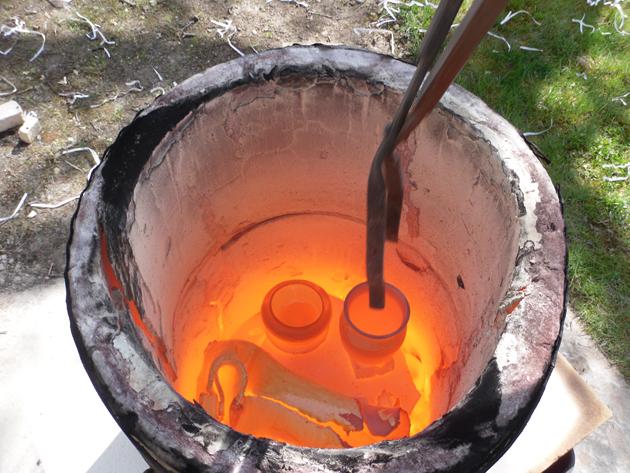
Ceramics Club members and enthusiasts gathered at the field behind the Miller Fine Arts Center armed with pots covered in glaze, copper wire and toothpaste. While the club hosts a wood-powered pit fire every semester, the April 24 firing also featured a new type of kiln: a raku.
Although only about eight people attended the firing, the event was an excellent experience, sophomore Josie Silberbach, president of Ceramics Club, said.
“It shows a much more hands-on way of firing than the traditional gas fire,” Silberbach said. “It also provides a different finish for the pots that cannot be achieved any other way. It gives the students a chance to be involved with their work from start to finish and to learn more about all aspects of firing and ceramics.”
A raku kiln is a cylindrical kiln made of brick, sophomore Ryan Kele, vice president of Ceramics Club, said. Pots are placed on a shelf inside the kiln, above a burner.
“The cylinder allows the fire to swirl up through the kiln and create a vortex of fire for even heat throughout,” Kele said.
After about an hour in the kiln, the red-hot pots are removed with tongs and placed into capped reduction cans filled with shredded paper. Silberbach estimated that the pots where approximately 1,800 degrees when they where taken out. The heat from the pot causes the paper to burst into flames and cook the pot a while longer, Kele said.
In a raku kiln, any part of the pot that isn’t glazed turns black. But the parts that are glazed produce vibrant colors unachievable in other types of firing.
A pit fire, on the other hand, features pots placed in a pit of wood and hay, which are ignited. When the wood burns to coal, Kele said the pit is covered to prevent oxygen from escaping. The pit was unloaded April 25. But the pit pots don’t get glazed.
“With the pit, the pots turn out with swirls of colors that can be anything from bright oranges, greens, blues, reds, white and black: The color all depends on what colorants you placed in the packing for you fired,” Silberbach explained.
These colorants are anything from copper wire to toothpaste to weed killer.
Not all the pots made it, though. Sophomore Christy Tanner, Silberbach’s roommate, said one girl’s pot exploded in the raku and took a chunk out of her pot. But she wasn’t too upset.
“The chunk came out very nicely,” she said.
And the mystery of what the pots will look like post-firing doesn’t bother Kele.
“It’s an escape from everyday life and the stresses of school work and other things,” he said about ceramics. “I can put all of that negative energy into the clay and create something beautiful out of it.”
For more information about Ceramics Club, please contact Silberbach at [email protected]
Kelley Hungerford
Managing editor Kelley Hungerford can be reached at [email protected]






